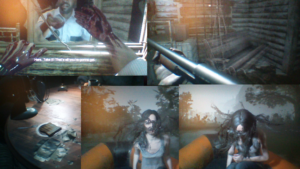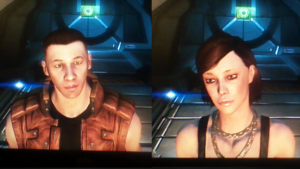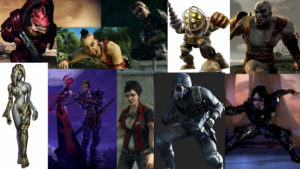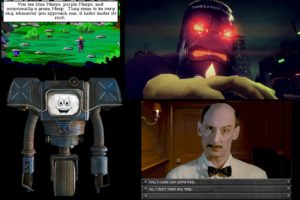Note: There are spoilers in this article.
Though Dead Rising 4 was released in December 2016, I was unable to play it until mid-March. I had to wait until it was made available for my favorite gaming hub, the Steam Network, before I could download it. Unlike Resident Evil 7, my resolve to stay spoiler-free until I could experience the game for myself was successful.
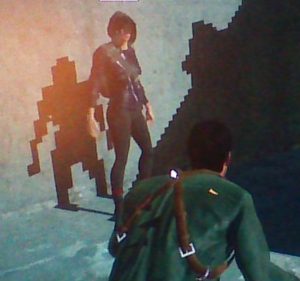 Like Resident Evil 7, I was certain that Dead Rising 4 would not run on my computer. I chose to test it anyway and was pleasantly surprised when it booted up – although the load time for the starting screen took a while. The only nitpicks I initially had were that shadows appear as distorted, blocky shapes, and there was a bit of a lag in the gameplay. But that’s nothing that ruined the experience for me. All I care about is that a game runs without crashing.
Like Resident Evil 7, I was certain that Dead Rising 4 would not run on my computer. I chose to test it anyway and was pleasantly surprised when it booted up – although the load time for the starting screen took a while. The only nitpicks I initially had were that shadows appear as distorted, blocky shapes, and there was a bit of a lag in the gameplay. But that’s nothing that ruined the experience for me. All I care about is that a game runs without crashing.
After the ending of Dead Rising 3 seemed to guarantee that there would be no more zombie outbreaks and that the story was over, the fourth game added another layer to the overall narrative. In a lot of ways, Dead Rising 4 goes back to the roots of the series – it features photojournalist Frank West as the lead protagonist, takes place in the town of Willamette after a zombie outbreak has started, and has an intriguing mystery at its core. It even lends some more depth to Dr. Barnaby, one of the antagonists in the original game who was responsible for starting the zombie epidemic in the first place.
One of the things I liked best about Dead Rising 4 is that, unlike its predecessors, there were no time constraints. Instead of rushing through the game to solve the mystery before the clock ran out, I took my time exploring and killing zombies to my heart’s content. I also love that the game brought back the option to dress the main character in a variety of wacky outfits, as well as create combo weapons and vehicles. To take it one step further, Frank has access to a piece of military tech called an Exo-suit that can amplify his speed and strength. In this outing, he throws cars at zombies to off them if he wants. So far, I haven’t made much use of the Exo-suits apart when the game makes it a mission objective to put one on. It is something to explore further.
While I encountered more than a few game glitches – my PC is old – nothing ruined the overall experience. The one that really got annoying was when I undertook a mission to take out all the zombies present inside a pool hall. Toward the end of the fight, the camera panned up to show a shot of some second story windows before a handful of the more aggressive zombies crashed through them; the camera angle remained fixed on the windows all through the ensuing fight and its aftermath. While I worked out a way to kill the remaining creatures regardless, I was unable to exit the building since I couldn’t face the door. Fortunately, this problem was corrected by loading the checkpoint given to me at the conclusion of the fight.
Apart from that glitch and the general lag in the gameplay, the other bugs I encountered regularly were seeing one or two zombies embedded inside a wall or walking into a room that is completely black. I couldn’t see anything even with night vision enabled inside these black rooms. While I enjoyed the game even with these glitches, I hope a newer, better computer will help eliminate them.
Overall, I liked the story developed for Dead Rising 4, but I also feel there are ways in which it could be better. For starters, the character of Vick, one of Frank’s journalism students, didn’t live up to her potential. In the opening chapter, I got the sense that she had a personal stake against the military group called Obscuris that was secretly creating and experimenting on zombies. Had Obscuris taken someone Vick cared about for their experiments? I was disappointed when this idea didn’t play out; Vick was simply a budding journalist out to write a prize-winning story.
I was also a bit disappointed with Calder, the “uber-zombie” hinted at during the first half of the game. I remember feeling a sense of dread as I chased him through a train yard filled with mangled, heavily dented cars and then into the sewers. I didn’t know what kind of monster to expect, but a highly intelligent former soldier decked out in an Exo-suit wasn’t quite it. What made it weirder was when Frank caught up with Calder, the latter was, for some unknown reason, hell-bent on destroying the research that created him.
I felt that Calder and his motives could have been fleshed out better. And if I had written the story, I would have had it so Vick and Calder were blood-related. That would have made for quite the dramatic climax.
The ending to the main game still had its share of drama. The final scene had Frank pulled from the rescue chopper by a horde of zombies and supposedly killed. However, there has been news of an expansion pack called Frank Rising that will continue the story and have Frank striving to find a cure for zombie-ism before he fully joins the ranks of the undead.
I don’t know if there are any revelations that would allow for another game in the series. Unless the company behind the Dead Rising franchise can come up with an intriguing, believable story for a fifth game, this may truly be the end of the road. Whatever the future holds, I’ve definitely enjoyed the ride so far!
Despite my enthusiasm for Dead Rising 4, the game got pushed to the side for about a week in favor of Mass Effect: Andromeda – more on that in my next blog.
